
Blog posting blew up on the internet a couple of decades ago. Ever since then, we’ve seen thousands of bloggers writing content on their websites, sharing ideas, and building a hyperactive content engine for their readers.
Fast forward to 2023, and blogging is still going strong. According to ReferralRock, 60% of blogs write 1-5 guest posts each month. Guest posting and blogging, in general, have stood the test of time because readers appreciate good, thought-provoking articles.
What is guest posting?
Guest posting is a link building strategy that involves writing an article for someone else’s website. Most guest posts include a backlink to the guest poster’s website, either in the author’s bio or in the blog post.
Businesses are eager to collaborate with bloggers because industry-relevant publications bring a much-desired SEO boost and increase brand awareness. This is where outreach specialists come into play. An outreach campaign is a marketing strategy that involves proactively reaching out to potential partners (brands, influencers, companies) that have a strong connection with your target audience. Cold outreach is when you contact people with no previous interest or engagement with your offerings. Successful cold outreach requires thoughtful planning, effective communication, and a genuine understanding of the recipient’s perspective.
Today, finding high-quality websites for guest posting isn’t a piece of cake. But it’s not impossible.
In this article, I’ll go over the ways you can find the right prospects and get published. By the end of the guide, you’ll know the steps to improve brand recognition and consolidate your position as an authority in your niche with the help of guest blogging.
Now, let’s get down to it!
1. Find potential websites that accept guest posts
The first step is to find the websites that can publish your post.
Search for websites that are open for guest posts
A good number of websites specifically mention guest posting guidelines. All you have to do is search.
Head over to Google to search your relevant keywords with special commands. You’ll find all the websites accepting guest posts in your niche. I like to do this with Google search operators to get super specific results. Here’s how I got relevant websites for “PPC”:
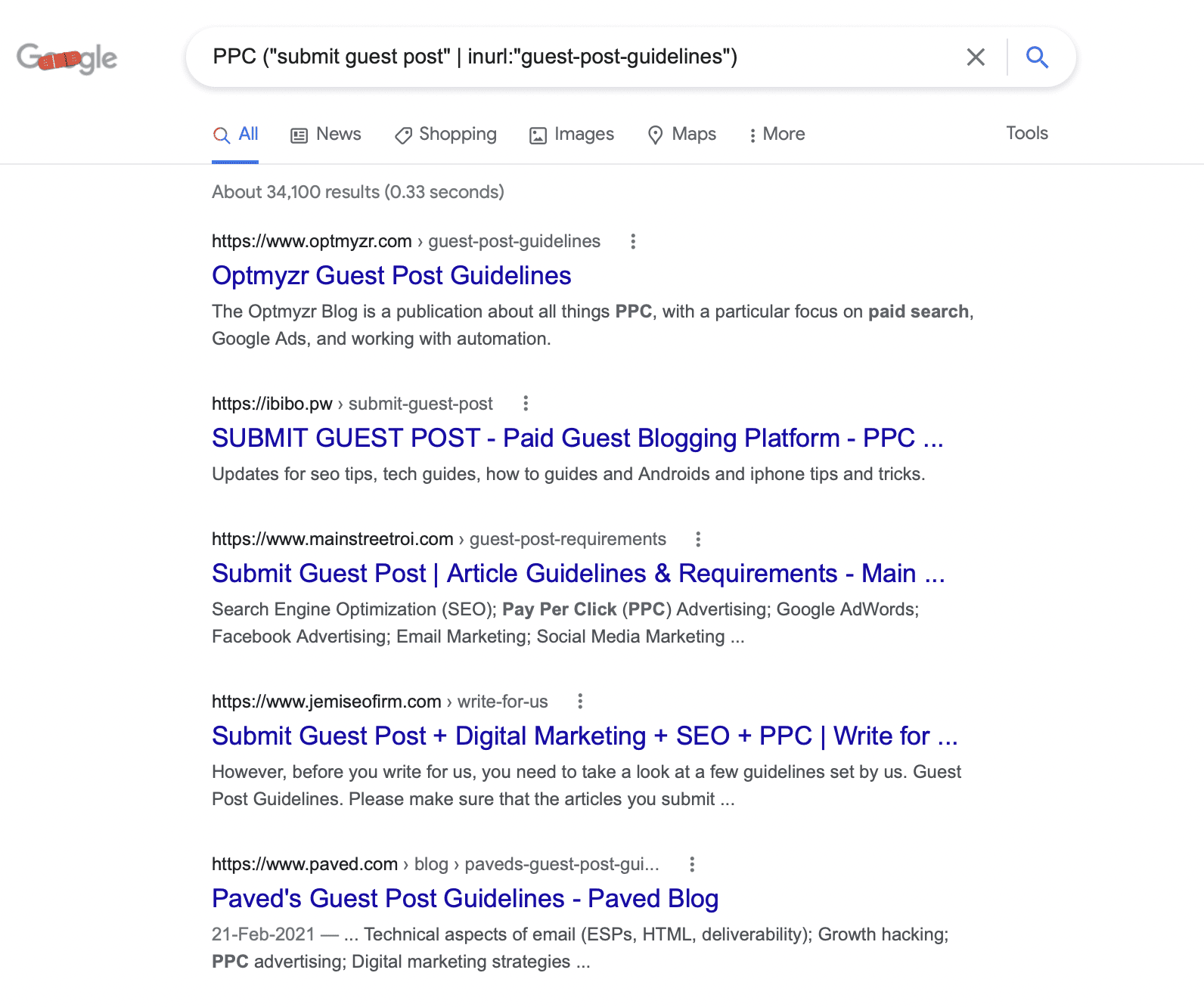
You can try various combinations to find more targets. Here are some good ones:
- (“submit a blog post”)
- (intext:”submit a guest post”)
- (inurl:”contributor-guidelines”)
This works great when websites advertise their guest posting program. But not every website does this. Another way to find relevant websites is to reverse engineer your competitor’s strategy.
Reverse engineer your competitors
Run your competitor’s website in SE Ranking’s Backlink Checker to find backlinks that are acquired from guest posts.
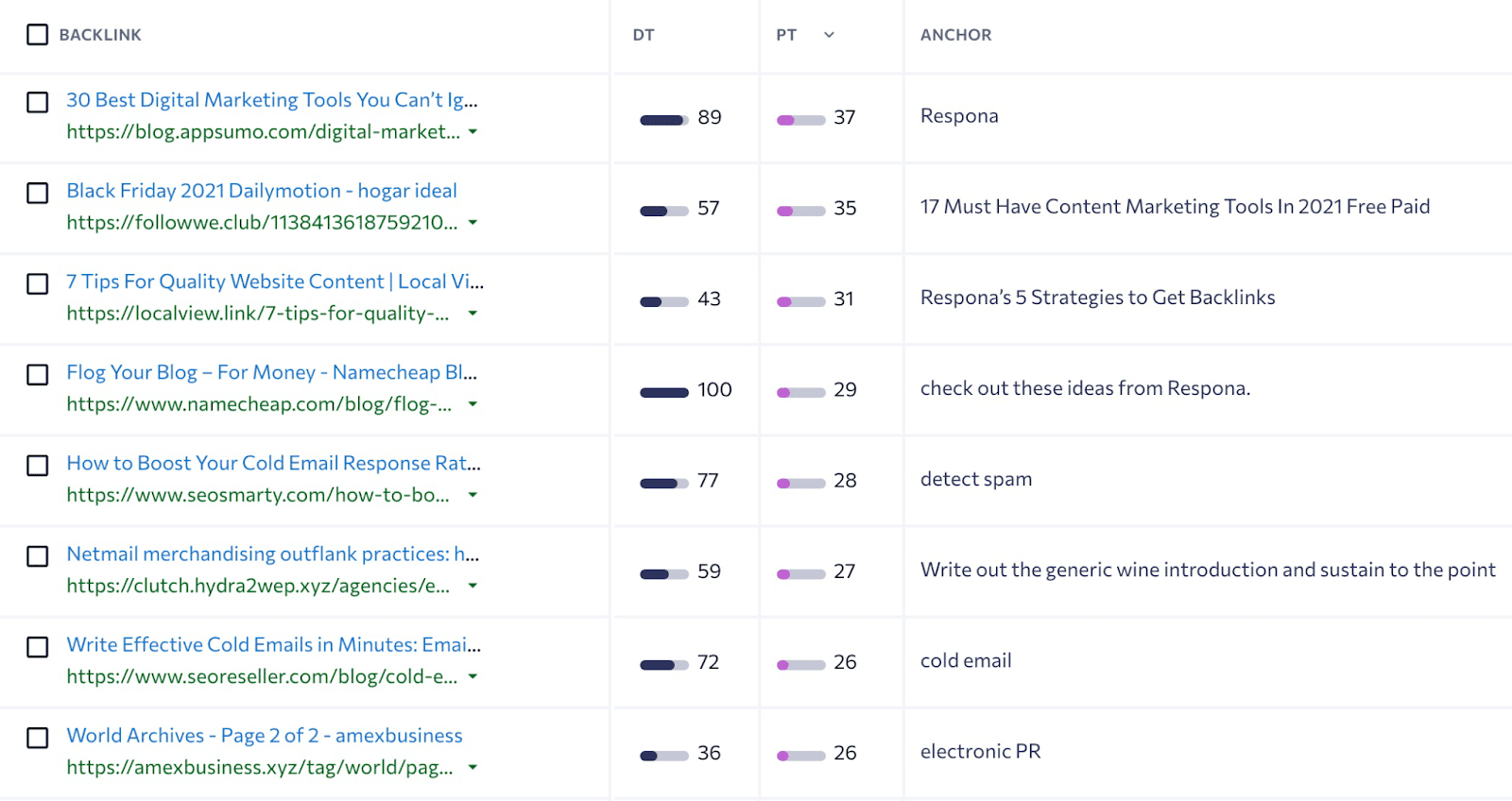
The easiest way to quickly find guest post opportunities is by checking your competitor’s referring domains. You can see a quick competitor research in the picture above. It is suggested to narrow your search by using SE Ranking filters such as:
- Only looking for dofollow backlinks. Always aim for a healthy ratio between dofollow and nofollow links. While reverse engineering your competitor’s links and looking for domains where they published guest posts, it is easiest to look at dofollow backlinks only. Reason? Most businesses still do guest posting for the sake of getting high-authority backlinks to their priority pages which means they are most likely to aim only for websites that allow dofollow backlinks.
- Set a specific Domain Trust (DT) range. Let’s keep it simple, the higher DT of domain linking to you is, the more authority you get. Getting links from higher DT domains help you to rank faster with fewer links for a given keyword. Keep in mind that just having a high DT isn’t enough for picking the website. Some websites have high DT but are exploited by selling links to everyone, which can actually decrease your rankings.
- Only looking for blogs in your targeted language. If you use Website Backlink Checker, you can quickly export the list of all backlinks for a given domain or a specific page. Once you have a list of backlinks, you can use a quick tool such as Url Opener that allows you to open multiple pages at once in your browser. Quickly scroll through a page and see if the page is a blog post, product page, homepage, or any other page type. Remove all results that are not blog pages and focus your outreach on blog pages in your targeted language.
Run advanced Google Search
Alternatively, you can get a pretty nice list of guest post opportunities by doing a quick Google search “author’s full name” + “author”. Most of the time, people with roles connected to content will get mentioned as authors of guest posts. Once you identify who is a responsible person for writing guest posts, it is easy to find untapped opportunities your competitors are utilizing.
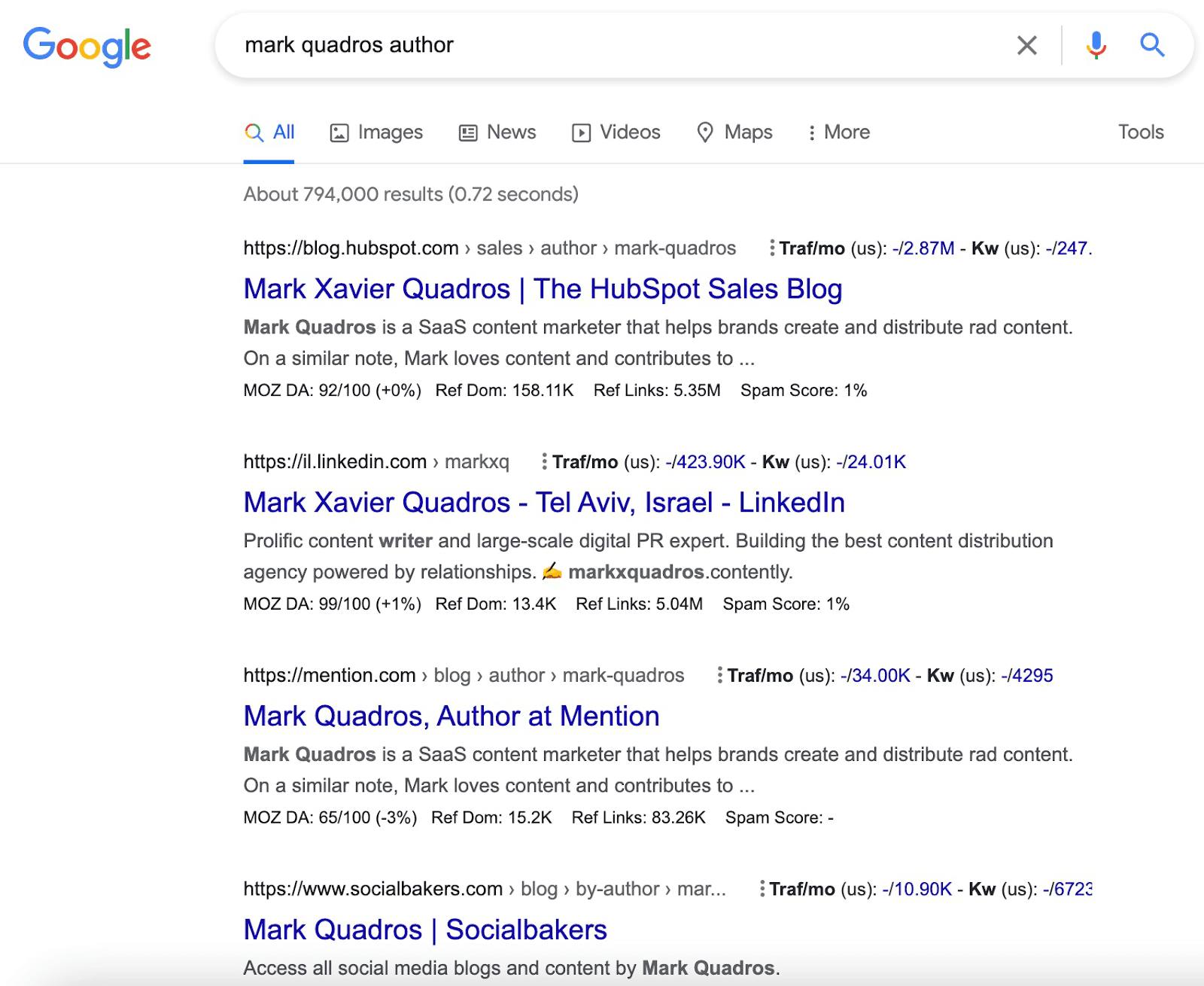
However, don’t give up if you can’t find in the open source info that a specific website accepts guest posts or if your author search doesn’t return any results. You can always do a manual search on the blog if you want to publish a guest post on a specific website in your industry.
Try searching manually
Yes, it’s more time-consuming but something that perfectly works. Let’s say your company’s focus is cyber security, and you want to contribute to the Aura blog, which is one of the leading industry blogs. You’ll need to check who contributed to them before, which topics were already covered, and create your pitch based on that.
In Aura’s case, their internal team created most of the content for their blog. However, if you double-check all of the author profiles on LinkedIn, you may find some external authors who previously submitted guest posts to their blog. For example, they accepted a guest post from the cybersecurity opinion leader Andra Zaharia on what is the dark web.
The only way to get your guest post published on the websites that typically don’t accept guest posts is to provide in-depth content on the topic of your expertise, something that brings great value to the guest blog readers.
Also, don’t hesitate to ask for an intro from those who previously submitted content to those blogs. For example, you identify a domain where you’d like to publish your guest post, but you know the editor probably gets dozens of guest post pitches per day. The easiest way to stand out from the crowd is to identify guest authors who have already published on the website, directly connect with them, and ask them for a quick introduction with the editorial team. It is important to mention this strategy doesn’t work—in the majority of cases—if you don’t have anything to offer in exchange for introduction.
Here are a few things that could work well in exchange for a quick introduction:
- Offer a free trial or a month subscription to your product
- Offer a backlink from your blog
- Offer a backlink from a guest post
2. Identify key decision-makers
A lot of blogs with DT 60+ and highly engaging communities don’t have a separate guest posting guidelines/write for us page. It’s because Content Heads and Editors want to reduce poorly researched inquiries they receive every day and want you to make an effort.
To get published on websites like these, you’ll need to find the people calling the shots. When it comes to guest posting, these are Head of Marketing, Content Marketing Head, Editors, SEO Managers, and PR Specialists. You can get their details from the website’s “About Us” or sometimes “Contact” pages, but they’re not always up-to-****.
LinkedIn is a great place to find relevant people working in a company. Just go through the employee list on the company page or search with keywords like this: [company name] + . You can repeat the same process on Twitter to find the decision-makers.

Once you have a list, add them to a spreadsheet to automate the outreach campaign. We’ll circle back to this point later.
Alternatively, finding websites that explicitly seek for contributors is always an easier way to get published, since you already know they are actively looking for guest posts and in most cases, they share their detailed guidelines—mostly to filter out the spammers and irrelevant pitches.
You can easily identify those websites by using operators in Google queries such as:
- (your preferred niche) + “write for us”
- (your preferred niche) + “guest post”
- (your preferred niche) + “contribute”
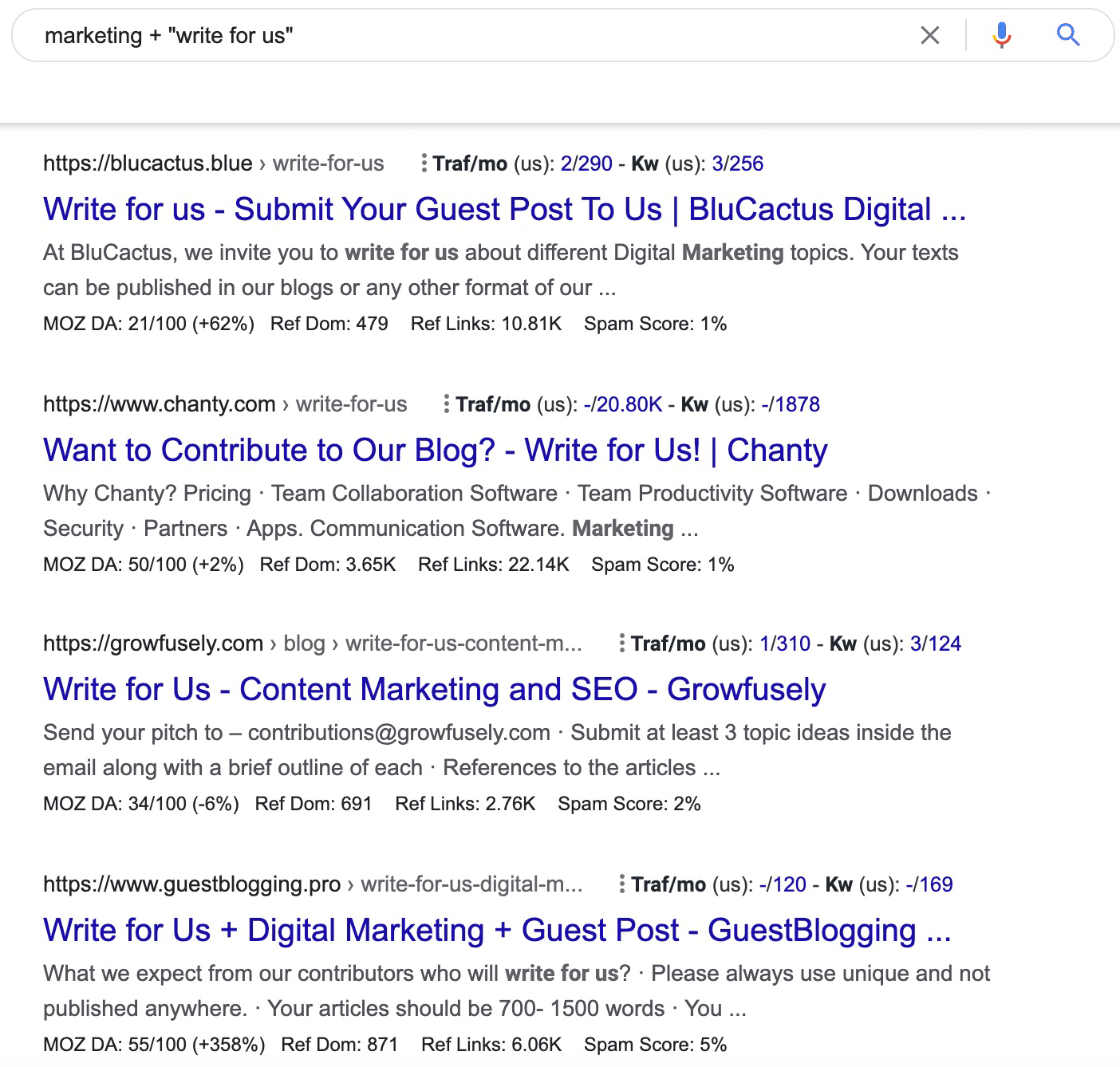
As you can see in the picture above, with just a single Google query, there are more than 100 potential opportunities. The best way to filter these prospects is by exporting all results and running them through Backlink Checker to get a better understanding of important metrics.

For example, if you’d like to write for Sender blog, they created a detailed form where you add your personal information along with your social profiles, previous publications, and guest post pitches. All relevant pitches will reach the responsible person increasing your chances to get your guest post published.
3. Interact and engage with your prospects before outreach
Guest posting in high-authority websites works a lot like a referral system. You have a much better chance of being seen if you interact with their posts or get a recommendation from a mutual connection. LinkedIn is, again, a great place to network with the content leads of companies before you actually pitch them.
Leave comments, share their posts, and look to share knowledge without asking for anything in return. You can also do this with an industry influencer to get a referral. With each movement, you’ll climb up the visibility chart. It is important to mention that it is an extremely time consuming process that requires a constant presence and engagement to get results.
A lot of people miss a trick by not leaving comments under blog posts. It allows you to fetch a reply directly from the writer, gauge the interactivity of posts, and break the ice when you cold email them later. Here’s a snippet of Moss Clement interacting with Bulk.ly’s owner, Chris Makara, who is known for accepting high-quality guest posts on his blog about social media marketing.

4. Find and verify contact information
Now that you have warmed the leads, it’s time to reach out to them. You’ll find contacts for guest posting within website pages. But, as I mentioned previously, high-quality websites don’t often share contact information to reduce spam.
If you have already added the names of the decision-makers in a spreadsheet, you can find their email addresses by using the free Hunter for Google Sheets add-on. It allows you to quickly search for contact information in bulk directly from your spreadsheet. In case you’re targeting only a handful of websites, you can find email addresses by running the domain or employee name through Hunter.

If you already have an address, make sure to verify it before sending an email. It’s not difficult to find old email addresses that are not active anymore. The cost of cold emailing to wrong addresses is too big to ignore. You’ll activate the spam triggers, increase the bounce rate, and end up reducing your email deliverability.
Once you have made sure your prospects will be able to receive your pitch, you have to find an irresistible topic.
5. Do detailed research for potential guest post topics
I have seen plenty of marketers unable to zero in on the topic they should write about. Consequently, their pitches never make it past the inbox. You have to learn how to create value for both your brand and the guest posting website.
A topic that gets greenlighted easily exhibits a few qualities:
- It’s relevant to the blog’s audience: At the end of the day, a blog post should help the readers. Guest posting websites usually accept pitches that resonate with their audience.
- It’s a topic of your expertise: You need to write on topics that reinforce your position as a thought leader within the industry.
- The topic hasn’t been properly covered yet: You need to find whether the topic has been covered already, to what extent, and if there’s a gap in the topic cluster. To find this, run it on Google: site:[website name] .
- The topic has traffic potential: It’s an amateur mistake to write an article on a topic no one searches for. Just because you know a lot about it, it doesn’t mean you should cover it in your blog post. Instead, you need to find the most popular keywords for the website and see if you can play around with them.
- Your writing aligns with the website’s guidelines: Guest posts shouldn’t feel different to the blog’s readers so you have to make sure it’s written in a way that aligns with existing content.
The ideal topic should tick all these boxes. Pitch 2-3 topics, instead of only one just to give editors a choice and impression you really did your homework.

You can quickly find traffic-potential topics that your prospects didn’t cover by using the Competitive Research tool.
With its help, you’ll be able to identify key competitors of the website where you’re pitching guest post ideas and find keywords they don’t cover but their competitors are ranking for. You can sort the report by keyword difficulty that shows the easiest keywords to compete for. Pick the keywords with at least 100 search volume and low difficulty. The pitch will look more interesting to your prospects, since there is a possibility your guest post will rank high and bring valuable organic traffic to their website.
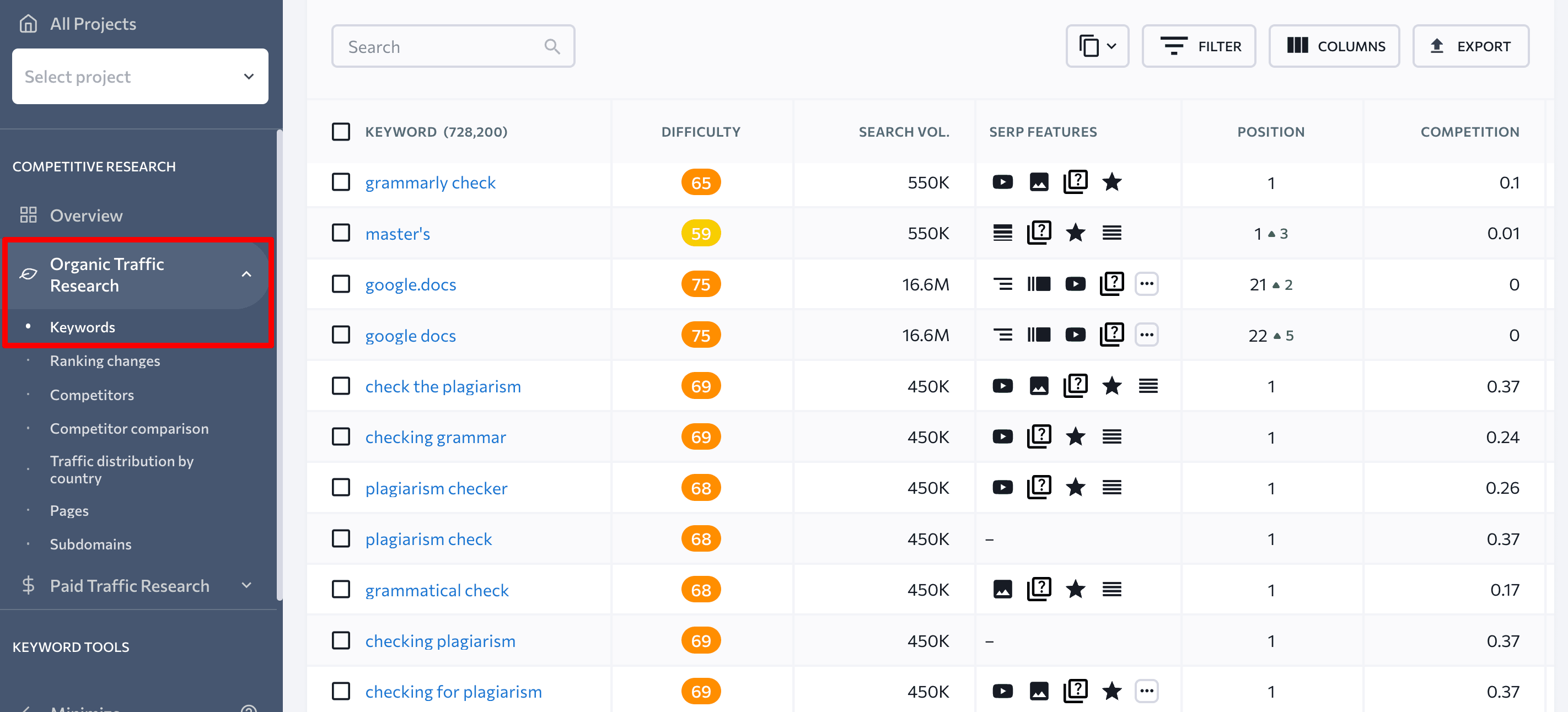
You can also research content trends by looking at the top-referring content for trending topics on Buzzsumo, a platform that helps people find relevant content.
6. Create a compelling outreach sequence
Once you have made sure you’re not emailing out of the blue and your topic is compelling, you have to write a killer email copy. For guest posting outreach, subject lines matter the most.
If you’re an established brand, you can go with a simple “Guest posting inquiry – [Your name] from [company name].” Things get tricky when you’re a new blogger or the website is insanely popular.
You have to pull in all the data from previous research and create a catchy subject line that shows you have made an effort.
Here are a few good ones:
- {{first_name}}, loved your post on [[topic]]
- [[valuable topic]] article idea for {{company}}
- {{company}} blog is missing this article
- You haven’t covered this topic, right?
- Guest post for {{company}}’s blog
These subject lines work because they’re precise, captivating, and short. Ideally, you don’t want to write subject lines longer than 5-6 words.
When you move on to the body of the email, it should include:
- A brief introduction
- A section where you briefly explain how your guest post will bring value to their blog and audience
- 2-3 relevant topic suggestions that have a fairly low keyword difficulty, people actually want to read about the proposed topic, and they haven’t covered that topic on their blog
- A strong CTA to set up a follow-up sequence
- A list of your previously published articles
Here’s a good example:
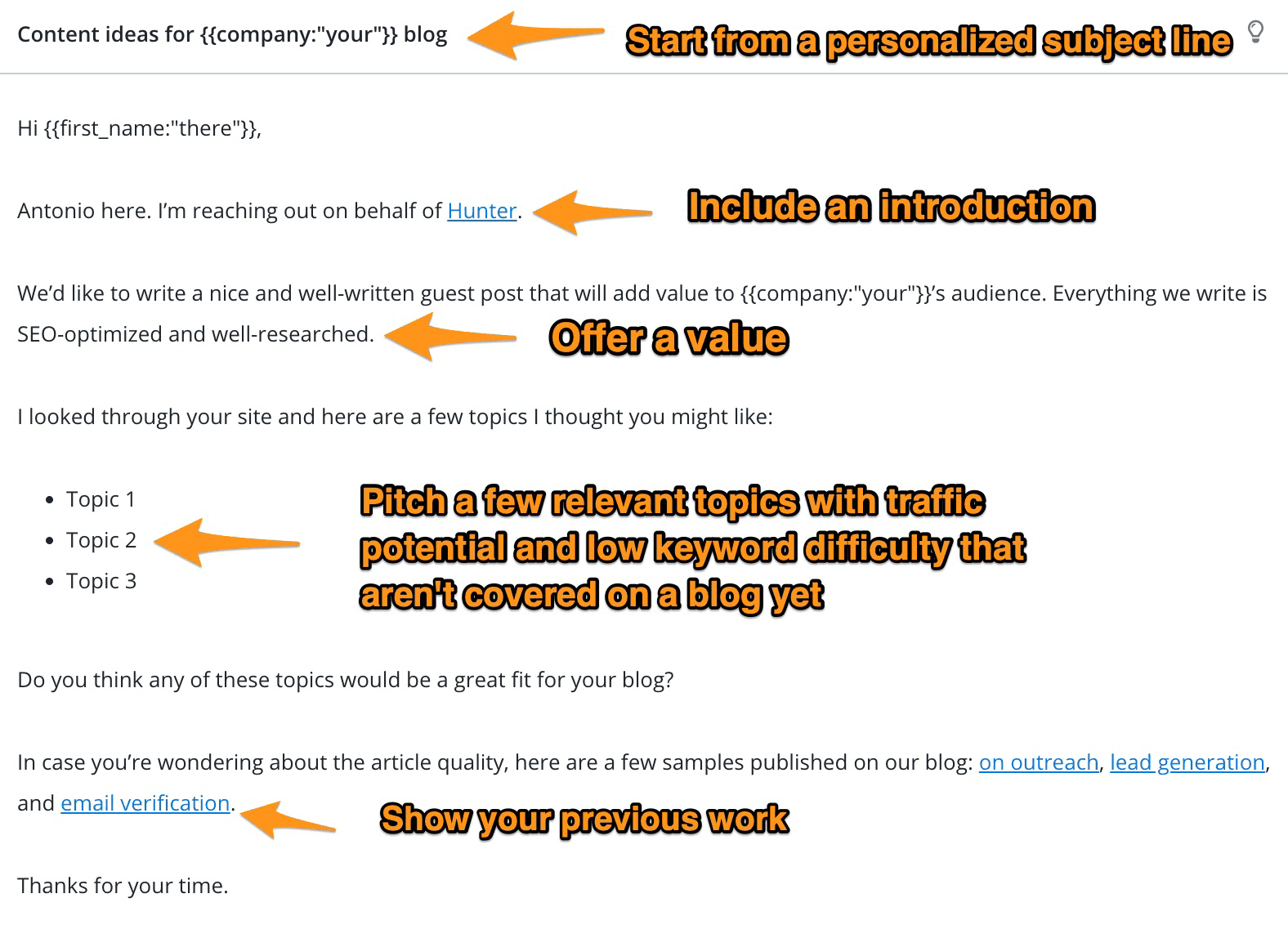
You can also add an e-signature that includes basic information about yourself such as your name, role in the company, and links to your social network accounts. Doing so can boost your credibility, help website owners learn more about you, and influence the likelihood that they will reply.
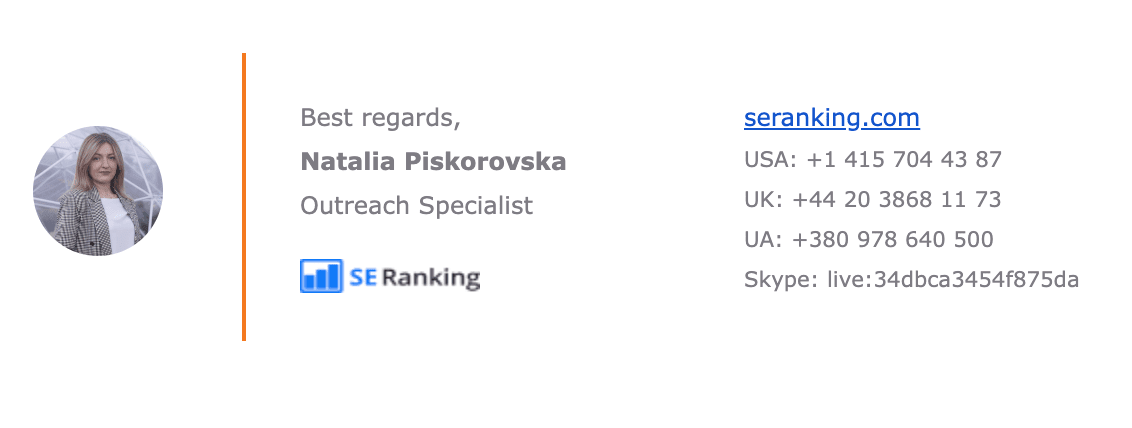
Editors can’t reply to all the guest pitches within a day. It’s a good idea to send a follow-up email with a couple of more topics and fleshed-out outlines after 5-7 days.
Hunter Campaigns allow you to automate a follow-up strategy and add a personal touch to get the best results. Guest post outreach can consume a lot of time and effort, and without automation, it’s difficult to scale quickly.
7. Negotiate
Once you get a reply from a decision-maker regarding the guest post, it’s time to iron out some details.
First, pick the topic that has the strongest blend of traffic potential and your industry expertise. If they have already covered the topic, persuade them to expand on some key concepts or publish a complementary post.
Second, discuss with a decision-maker about fine details and requirements—usually in guidelines—such as how many words a guest post should have, how many external links you can add, do you get an author’s bio at the end of the article, are links dofollow, etc. Even if that information is available in their guest post guidelines, you always want to confirm these details, as “write for us” pages can be outdated.
Once everything is clear from both sides, it is time to schedule the publication. Be transparent about your writing schedule so editors have a better idea of when the article will be ready for their review and potential publication time. Keep in mind that guest posting isn’t a quick win strategy, and the more authority the website is, the harder it will be to get published.
Many guest bloggers nowadays collaborate with multiple companies, so they always look for the ways to add extra external links. Not many editors will be happy to do it, so you should always think ahead and prepare to give some value in exchange for your request such as:
- Offer a link from your specialized website. A huge plus is if you own or manage a high DT website which is relevant to their audience and content.
- Offer a link from your upcoming guest posts. Share your guest post drafts with them so they can suggest relevant link placements.
- Offer a link to the guest post you are writing. Depending on your network, you can possibly build a few links to the guest post you are writing for them in exchange for adding a bit more external backlinks.
- Share their content on your social media channels. It only works if you have an engaging social media profile or highly relevant community where their potential audience is.
8. Write the guest post
Once all key points have been approved, it’s time to write.
Before getting started, go to the website for which you’re guest posting and review their content to get a feel for their writing style. Make sure to follow the site’s guest post guidelines as you write.
Concentrating on your writing is crucial because even if your topic has received approval, the final output could still be rejected. Research the SERP to create a brief and determine how to outperform other websites who are in the top 10 in terms of headings and keywords. Run your final work through a grammar, readability and plagiarism checker to ensure it is error-free. You can do all of this with SE Ranking’s Content Editor, which analyzes your text based on SEO parameters, checks for plagiarism, offers tips on improving your text quality, identifies appropriate keywords to use, and even uses AI technology to help you write.
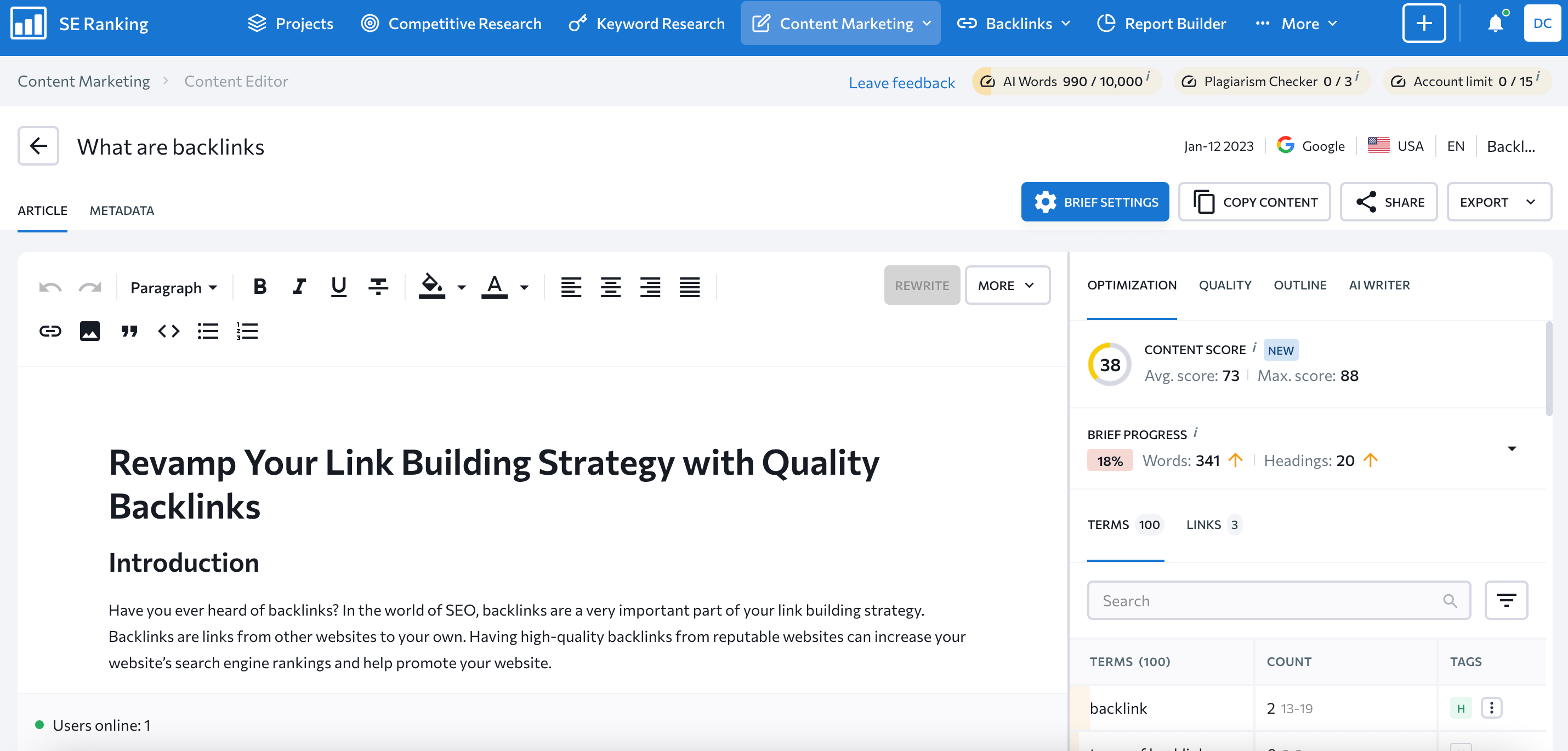
Make sure the final version of your blog post contains links to any relevant blog posts or landing pages that have already been published on the owner’s website. This will reduce the workload for the website owner with whom you’re cooperating.
9. Send the article once ready and be prepared for edits
Once you are done with writing and all edits, it is time for you to send the finished version to the editor. Keep in mind that writing for a high-authority website sometimes requires a few rounds of editing, so arm yourself with patience and deliver requested edits in a timely manner.
Before sending the article to the editorial team, it is important to review their guidelines and apply all the edits to adopt to the guidelines. For example, you could use more than 10 hours to produce a well-researched and optimized article but failed to add a few screenshots as stated in guidelines, which could be a reason enough for some editors to reject your article. A good approach is to add the most important aspects from guidelines in your to-do list and review the article for each aspect.
If it is the first time you’ve experienced many edits, don’t worry, as it doesn’t mean that your article doesn’t provide any value, but rather, editors want you to adjust your writing style and tone to their audience. Also, you’ll be able to cover a topic through more perspectives, which ensures a high quality of your article helping you to build a better writing portfolio.
Since editors of big websites handle multiple guest posts per day, it is easy for them to lose track of all requests and conversations. Always make sure to create a follow-up sequence without being annoying or spammy.

Gmail offers an in-built snooze function that reminds you about a specific conversation. Whenever you send an email to the editor, be sure to snooze it just in case that editor gets packed with conversations and misses your email. When it comes to following up, make sure to write the email in the same thread, as it can easily become messy to track previous conversations in multiple threads.
In case you don’t get the answer after a few follow-ups—don’t overdo it—you can try to connect with the editor on LinkedIn or try to reach out someone relevant from the company who might answer to you and possibly connect you with alternative contact in case the editor isn’t working for the company anymore.
10. Once you published a guest post
Once the article is published, check whether everything corresponds to the agreements regarding mentions, screenshots, writing style and structure, external backlinks and similar. If everything corresponds to the agreements, don’t stop there. Nurture the relationship with the editor because you never know what opportunities may grow from this relationship.
Here are a few post-publishing things you can do to furtherly nurture the relationship with the editor:
- Share a published guest post on your social media profiles and relevant communities
- Repurpose parts of your guest posts and create an engaging Reddit post with the link to the original article
- Build authority and relevant backlinks to the guest post, and don’t forget to let the editor know about new acquired backlinks
- Introduce the editor to potential link-building collaboration
- Track the comments on your blog posts and respond to them
If your article includes an important backlink to your site, be sure to monitor it closely. SE Ranking has a Backlink Monitoring tool for this purpose. It will notify you if the backlink is lost and also provides information on the indexing status of the page where your guest post appears.
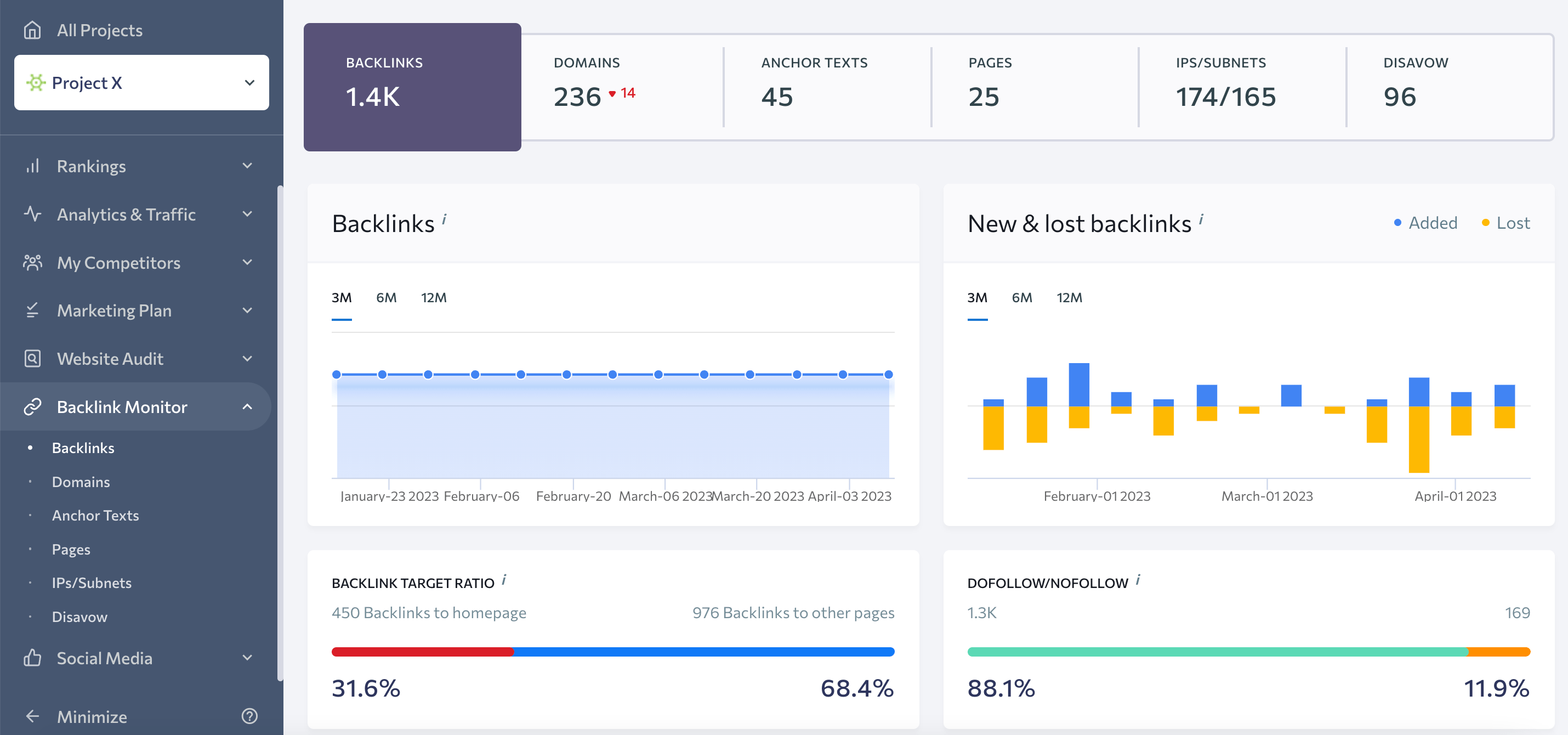
You should always strive for giving additional value after your guest post gets published since showing initiative often opens doors to more opportunities.
Wrapping up
Guest posting works the best when you prioritize sharing industry knowledge with a new set of readers. Before pitching a guest post, make sure to warm up the lead, dive deep into the audience’s preferences, and find any content gap that you can address. By combining email lookup, campaign automation tools, and expertise in the industry, there’s a good chance you’ll be able to build a solid guest posting portfolio in no time.

![YMYL Websites: SEO & EEAT Tips [Lumar Podcast] YMYL Websites: SEO & EEAT Tips [Lumar Podcast]](https://www.lumar.io/wp-content/uploads/2024/11/thumb-Lumar-HFD-Podcast-Episode-6-YMYL-Websites-SEO-EEAT-blue-1024x503.png)

